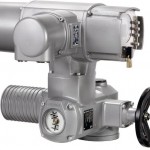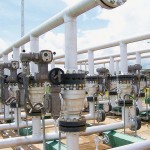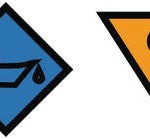Today, data collection and safeguarding is like child’s play. Drawing correct conclusions is more difficult though. The case must be solved by both the secret services and the operators of process plants. In this article, however, we do not want to deal with the problems of secret services but present the actions taken by Auma as electric actuator manufacturer to make sure that the devices supply the plant operator and the service staff with useful information on device status.
Electric actuators are used for valve automation in a multitude of process applications. They are composed of a gearbox with a flange-mounted electric motor and integral controls, which contains the switchgear for motor control and the communication interface to the DCS. Interfaces for all conventional process automation fieldbus systems are available, like e. g. the various Profibus DP protocols. However, traditional parallel control is still used. Electric actuators are always equipped with a handwheel and an activation mechanism to allow for modification of the valve position in the event of power failure. The integral controls either control the actuator via the binary operation commands Open – Stop – Close, or a valve position to be approached is defined by the DCS using a setpoint. The controls perform actuator positioning. Upon reaching a valve end position, the actuator is switched off automatically, either via position feedback signal or when reaching a pre-set torque limit.
Modern actuator controls are equipped with microcontrollers. Since their introduction about 20 years ago, the functionality of actuators has been extended tremendously. Already in the 1990s, the basic facility of preventive maintenance by logging and assessing operating data of field devices was identified. Due to the development of fieldbus systems, the technical prerequisites were created to transmit a larger number of status data from the field device to the DCS than via parallel communication.
The first steps into this direction were not very successful; this was due to the fact that the definition of a technical standard for data transmission turned out to be a necessary but insufficient condition. The additional data flow reduced transmission speed of information relevant to process control and, furthermore, overstrained the DCS and consequently the plant operators. Device operating data was mainly used for service purpose supporting the device specialists with fault diagnosis. However, at that point in time, the failure had already occurred. In turn, the objective of preventive maintenance is to anticipate failures.
This topic is keeping a lot of people very busy with the development of guidelines for implementing asset management systems. The basics are always the same. Seen from the perspective of the field device manufacturer, the online plant asset management, also called plant asset management, is of particular relevance.
Within this context, assets are considered as plant components relevant to an industrial process such as apparatus, vessels, machines, piping and process control technology instruments and equipment. The objective of online plant asset management is to preserve or enhance the value of a plant by undertaking maintenance measures.
As a general rule, online plant asset management uses at least parts of the infrastructure facilities for process control, however with separate management. Whereas process-relevant data is processed in process control to ensure coordinated performance, an asset management system provides above all online information for the technical assessment of plant components. This is in the authority of plant engineering, whereas process control lies within the responsibility of the plant operator.
Up to now, technical plant engineering performed regular maintenance tasks and reacted once a failure occurred by removing the cause of failure. Important and costly plant downtimes can be the consequence. As a matter of fact, an asset management system has two tasks: To signal conditions causing a failure so that measures can be taken to prevent these situations, and on the other hand to supply complex information on the maintenance requirement of a device to eliminate the static maintenance intervals.
Intelligent electric actuators
Modern electric actuators are field devices with internal status monitoring, e.g. they monitor independently that specified operation conditions are met. This includes the respect of pre-defined operation times or the recording of the number of starts. These variables are easy to record with the available microcontroller technology. Monitoring other variables requires additional hardware within the actuator. Apart from the existing torque monitoring, sensors for continuous recording of temperatures (motor, gearbox and electronics) and a vibration sensor are available. Consequently, all conditions are fulfilled to supervise all variables which could cause failures. Device status assessment requires exact knowledge of the service history. Therefore, all measurement values are recorded in a time-stamped event report.
It is not only possible to monitor device-specific service conditions, like permissible ambient temperature, also permissible vibration, max. number of starts or operating times, but customer-specific limit values can be defined. For example, a torque characteristic can be imported after commissioning. Feedback is sent if the torque differs by a predetermined limit from this reference during operation. The technical plant engineering is responsible for this type of assessment. Is the increased torque due to modified process conditions, for example higher service pressure, or does the valve stem require greasing to upgrade the torque requirement to reference level?
Unambiguous communication
Exceeding predefined limits are spontaneous events. These events must appear on the plant operator display to allow for immediate introduction of corrective actions. Considering that a plant consists of a multitude of components made by different manufacturers, it becomes obvious that device feedback must comply with defined schemes. The objective is that the plant operator can take appropriate actions to eliminate the problem.
One approach is to classify status signals into four categories, in compliance with Namur recommendation NE 107:
- Out of specification: Deviations from the permissible application conditions determined by the device itself through self-monitoring. The device can still be controlled from the control room.
- Maintenance required: The device can still be controlled from the control room. The device must be inspected by a specialist to avoid any unscheduled failure.
- Function check: Due to ongoing work on the device, it cannot be controlled from the control room at that very moment.
- Failure: Due to functionality failures within the device or the peripherals, the device cannot be controlled from the control room.
The device manufacturer must classify the status signals of his/her devices using these categories. For example, if an actuator senses an ambient temperature out of device specification, the plant operator will receive the respective symbol with the device identification. He will inform the plant engineering accordingly and they have to investigate the origin.
According to NE 107
A similar procedure will occur if the torque is outside the tolerance band width around a reference characteristic. The maintenance symbol will be displayed on the plant operator display and the service staff will be informed accordingly about the appropriate measures to be taken.
Monitoring actuator-specific service conditions and limits as well as the indication of events according to NE 107 categories are implemented. This helps to prevent actuator failures and downtimes.
In a next step, the continuously available „maintenance key“ has to be defined supplying information on the actuator status. The available data obtained from lifetime tests will be fed into formulas stored within the actuator firmware. The maintenance key supports the technical engineering in scheduling maintenance measures as required.
Online-Info www.cpp-net.com/2210401
Share:









